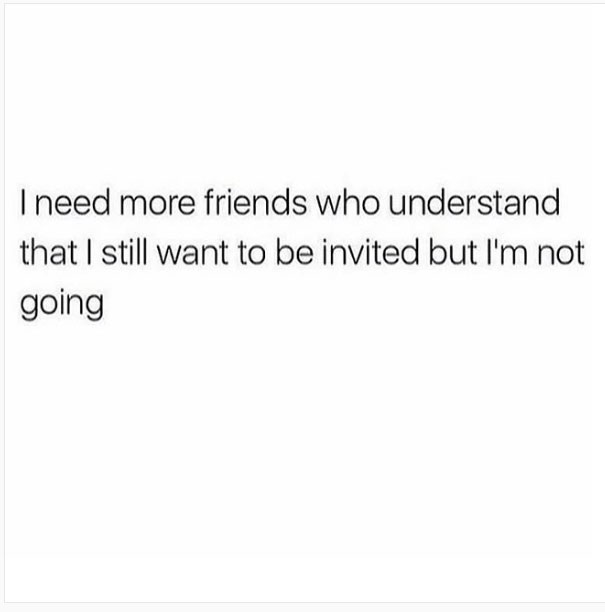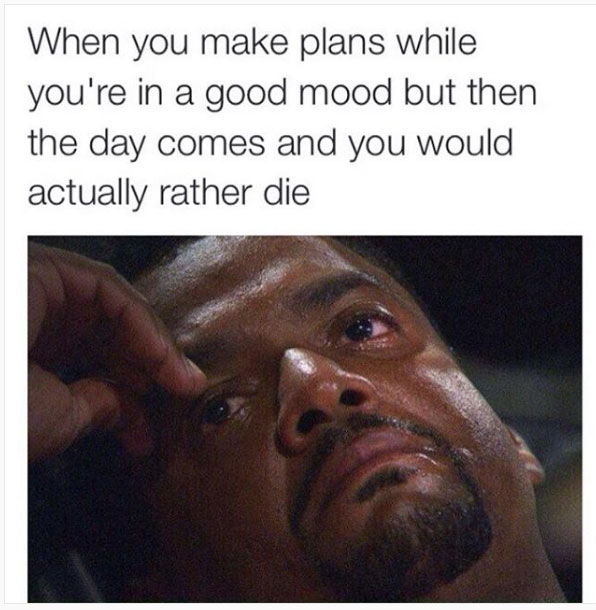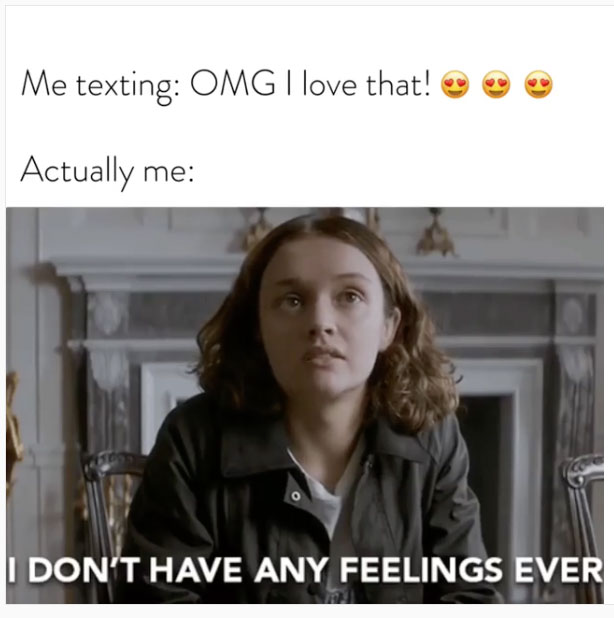Instagram tells millions of stories. Many exhibit our personal daily moments, and, from a wider lens, others describe entire populations and social movements. With 800 million users, Instagram is one of the biggest and richest collections of societal data on the planet. We can learn a lot by noticing what these users choose to showcase personally and which accounts and posts they choose to follow. Lately, I’ve been paying attention to the latter.
Of course, Instagram has grown since its conception, from personal accounts to brand accounts. It seems every business, school, group, dog and fetish now has an Instagram account. “Celebrities” — foodies, beauty experts, daredevils, singers, comedians and more — are born on Instagram.
In the past year, I’ve been following a few comedic accounts that display almost exclusively memes. A “meme” comes from the concept of memetic theory, championed by Richard Dawkins in his 1976 book The Selfish Gene. Just as genetics connote characteristics passed from generation to generation, memetics refer to cultural ideas transferred from person to person. A meme spreads quickly because it can reproduce itself, jumping from mind to mind and therefore driving cultural influences across the globe. According to the theory, genetics and memetics are similarly affected by Darwinian rules of evolution: Their success is subject to their contribution to the effectiveness of the person carrying them.
Memes can concern any content, but the “units of culture” I have been focusing on seem to be targeting people in their mid- to late 20s who are still navigating the transition from youth to adulthood. I’ve noticed a trend in these memes that seems both disturbing and completely normal.
Here are a few that have been featured and reproduced on multiple accounts:
Posts of this kind receive an immense “ovation” of likes, comments and shares. More than 250,000 people liked the first meme, and more than 14,000 commented. Most comments “at” (or link) a friend’s account, inviting him or her to view the same post, and they remark together on the accuracy and truth of the message. These comments include:
“haha, us literally.”
“Lol my life story.”
“So accurate.”
“Us every day, all day.”
“Literally EVERY f*cking time, without fail…! Millennials & bad drivers make being an agoraphobe so much easier nowadays!”
Most memes display simply black Arial font on a white background; they seem to rely entirely on the words that compose them. Others feature text accompanied by graphics, pictures or GIFs, such as this one:
But even as memes become flashier and more complex with recycled photos or videos, the rule of Darwinian evolution remains critical: The success of memes depends on the effectiveness of the person carrying them — in this case, the account holder. The popularity of a meme, evidenced in the comments section, seems to multiply if the account holder’s caption provides funny, insightful, witty commentary on the meme: in essence, a meme upon a meme.
For example, in the third meme, an account holder captioned the image with: “I’m At Lunch Not Talking To The Person I’m With, But Instead Looking At A Facebook Photo Of The Lunch Belonging To A Girl I Haven’t Seen Since […] 2007.”
This caption — using a relatable, all-too-real anecdote — brings new life and humor to a recycled post. It successfully reproduces the memetic, refueling the cultural influence and giving it new shape before it is passed on.
Users react accordingly, many of them employing the “Face with Tears of Joy” emoji as they comment specifically on the caption:
“Hahaha omg ur caption”
“the caption!!!”
“what if ur sitting with a really boring person at lunch”
“hahaha the caption tho”
I simultaneously find myself laughing about and relating deeply to these memes and their captions. Even if my feelings don’t agree in the moment, many of the messages tap into emotions, reactions or thoughts that I’ve certainly had. I have wished that plans would fall through. I have spent too much time scrolling through Facebook. And I have used emojis and exclamations in text that I would never say or emote in real life.
Meanwhile, I can’t help but feel disturbed by these messages and the amount of praise and endorsement they receive. They are all deeply sad and negative in tone and content because they seem to connote a total lack of feeling, social inclination and zest for life, yet at the same time, the need to be liked, included and embraced.
For this reason, I started saving memes of this kind to a “collection” — an optional, user-controlled repository for images on Instagram — that I titled “Oxymoron.” The contradiction of craving and simultaneously rejecting social interaction became an apparent theme that puzzled me. I started asking myself and lots of other (mostly 20-something) people: What’s going on here?
Some friends, while acknowledging that we’re naturally social animals, offered a simple answer. “After working a 12-hour day, that desire to socialize becomes secondary to my need for sleep,” Kelly, 28, explained. “I’m so happy if plans fall through because I feel exhausted by the idea of devoting any more energy to anything in my day.” Others echoed similar ideas and sentiments.
But this explanation didn’t seem to capture the full picture, and it seemed even my busy friends agreed. As our email exchanges developed, so did our ideas about other possible contributors to what seems like an age of isolation, neediness and sadness. After all, depression rates for teens and young adults are higher than ever (12.7 percent as of 2015, according to Psychological Medicine). The chief perpetrators, we concluded: social media and smartphones.
Socializing without the authentic self
Comedy is successful when it shamelessly and nakedly brings to light the truest feelings we all possess but don’t readily admit to or talk about. It can be an immensely satisfying relief to hear our private thoughts, habits and emotions exposed and articulated in an anonymous way that lets us know we’re not the only ones experiencing them — that we’re not alone.
And we will do anything to avoid feeling lonely. We will maintain friendships that we don’t enjoy. We will agree to plans that we don’t look forward to. We will stay in relationships that make us unhappy. We will join gangs, extremist groups and cults. In studying our basic human needs, Abraham Maslow determined that we will even sacrifice our safety for the sake of belonging, as evidenced, for example, by children who cling to abusive parents.
Loneliness is deadly. According to research conducted by Julianne Holt-Lunstad, professor of psychology at Brigham Young University, loneliness has the same effects on our health as smoking 15 cigarettes a day. It is more fatal than obesity.
Conveniently, smartphones have given us a tool to dismiss and evade feelings of loneliness quickly and with little effort. Texting, of course, provides the sense of company and togetherness in any and every moment. But even scrolling feeds on Facebook or Instagram can make us feel invited into the lives of friends whom we might not readily meet up with or call.
“We know that engagement with social media and our cell phones releases a chemical called dopamine,” noted Simon Sinek in a 2016 interview on Inside Quest. “That’s why when you get a text, it feels good. It’s why we text 10 friends when we’re feeling a bit lonely, a bit sad. … It’s why we count the ‘likes’ on our Instagram.” And we can do all of this without getting off the couch, without putting on fresh clothes and — best of all — without actually speaking to anyone.
Because socializing in person, face-to-face, is hard. We’re required — in real time — not only to process and listen to what others are saying, but then also to compose (witty, sensible, empathetic, affirming, interesting) comments in reply, sensitive to the situation, conversation and environment. All the while, we must align our facial expressions to the context and content, some of which changes by the second. If live conversation can be described, as it often is, as “dancing,” then texting or using social media might be described as a card game. Both require thought and strategy, but in-person communication demands spontaneity. It commands us to be our authentic selves.
But that can be complicated and challenging. What if we don’t like who we are? What if we don’t know who we are?
The pressure to be perfect has never been more intense. In his 2015 bestseller Sapiens: A Brief History of Humankind, Yuval Noah Harari wrote, “If you are a teenager today, you are a lot more likely to feel inadequate. … Even if the other guys at school are an ugly lot, you don’t measure yourself against them, but against the movie stars, athletes, and supermodels you see all day on television, Facebook and giant billboards.”
Social media allows us to craft, edit, filter and recraft ourselves so that we can come closer to this ideal. We can even consult friends before we reply to a text or post a photo, giving us the ability to depict the (airbrushed) story we wish to tell. But allowing real-time spontaneity to eventually and inevitably reveal who we really are can feel risky and terrifying.
Brené Brown boils this down to a deep aversion to vulnerability. Because we are social animals, we need to feel connected and a sense of belonging in order to survive. “Connection is why we’re here,” Brown said in her 2010 TED Talk. “It’s what gives purpose and meaning to our lives.”
And it is the fear of disconnection, Brown asserts, that often makes us feel the most challenging feelings, like vulnerability and shame.
A downward spiral of loneliness
The memes I have observed and collected are popular because they send the message that putting ourselves out there is not worth the risk. No one else is going out; why should you? Why let yourself feel judged, offended or not good enough?
But “for connection to happen,” Brown continues, “we have to allow ourselves to be seen. Really seen. …When we numb vulnerability, we numb joy, gratitude, happiness.” We must accept who we are and embrace vulnerability. People who are most connected, Brown found, “were willing to let go of who they thought they should be in order to be who they were. You have to do that for connection.”
The concern that has nagged me over the past year is that these memes openly reject this kind of self-exposure and authenticity, essentially instructing us to give in to our fear of vulnerability. This not only prevents others from knowing us, it prevents us from knowing ourselves. We get stuck, therefore, in a developmental stage that looks and feels a lot like adolescence — afraid of judgment, lacking self-confidence and without a sense of true belonging.
Another distinct and crucial feature of face-to-face conversation is the opportunity for touch. A pat on the back, caress on the arm, stroke of the hair or hold of the hand is essential to our mental and physical well-being. “Being touched increases the number of natural killer cells, the frontline of the immune system,” says Tiffany Field, founder of the Touch Research Institute at Miami Medical School. “Serotonin increases. That’s the body’s natural antidepressant.”
Deprivation of the sensation of touch from another human often results in feelings of isolation, social exclusion and depression. What’s more, these feelings make people fearful and put them “into a kind of defensive state where the levels of cortisol [the hormone released by the brain in times of stress] are raised,” says Kellie Payne, researcher at the Campaign to End Loneliness. “Having had negative experiences, they anticipate that their connection with people will also be negative, which makes it hard to reinstate contact.”
In short, lonely people can get trapped in a downward spiral of loneliness. These memes tap into and perpetuate this vulnerability, actively discouraging ambition, social connection and productivity.
Fortunately, our brains are resourceful; they find alternative ways to satisfy our needs. For many, this compensation is happily found in communicating via text message and social media. That dose of dopamine can be the fix we need in sad or lonely moments so that, with the approval and company of tens of thousands, we can quickly wipe them away.
Returning to Maslow, these memes, therefore, allow us to reach the two highest orders of human need: esteem (being accepted and valued by others) and self-actualization (reaching our full potential; being all we can be).
The problem is that this solution is shallow, artificial and temporary. Because although it feels like we’re raising unspoken issues of loneliness and depression, and relating to others when we like or comment on these memes, we’re not actually facing our feelings or each other, or talking about them in a way that allows us to be honest, authentic or vulnerable. At the end of the day, the humor used in these memes is merely numbing and normalizing some of our deepest and truest emotions by providing a false sense of togetherness and belonging that inevitably lets us down.
But because “connecting” to others via social media has become so easy and satisfying, like any dopamine producer, it is highly addictive. We’re no longer willing to devote energy, time and effort to our relationships (or any project) because it is —comparatively — too hard.
In other words, social media has yet to find a way to produce serotonin: a far more gratifying, long-lasting and pleasure-inducing hormone. Serotonin provides a sense of relationship, allegiance and pride after dedicating time and effort to a project or task that transcends selfish motivations. But when a meme caption says: “If you do anything interesting or important today, you can go f**k yourself,” we’re excused from trying. Instant gratification has overtaken meaningful, lasting reward, and dopamine has overtaken serotonin.
And just as any addiction — drugs, food, sex — is, by definition, extremely satisfying in the first stages, it often loses appeal, allure and thrill as it becomes more intense and demanding. The craving or desire becomes a need or chore, and we in turn become a slave to our addiction. These memes and apps such as Instagram are designed not only to “rescue” us in times of loneliness or sadness, but to draw us in constantly, at all times of day and night.
“That itch to glance at our phone is a natural reaction to apps and websites engineered to get us scrolling as frequently as possible,” wrote Bianca Bosker in a 2016 edition of The Atlantic. “In short, we’ve lost control of our relationship with technology because technology has become better at controlling us.”
When we are or feel controlled, we lose our sense of self and self-worth — our ability to produce, invent and create. The majority of Instagram users are merely consumers of information; only a small percentage of users are actually creating the message, the humor and the trend. It requires far less thought and effort to simply “at” a friend or double tap to “like” a photo than it does to lean in and think about and interact with society so that we can create our own ideas — or even just talk to one another about them.
****
Adriana V. Cornell has spent the past two years living in Nairobi, Kenya, working as a school counselor and college counselor at an international school. She has worked primarily with high school students and has focused her writing and research on students in transition and social media. She moved back to the United States with her husband in July. Contact her at adriana.v.cornell@gmail.com.
****
Opinions expressed and statements made in articles appearing on CT Online should not be assumed to represent the opinions of the editors or policies of the American Counseling Association.





Comments are closed.